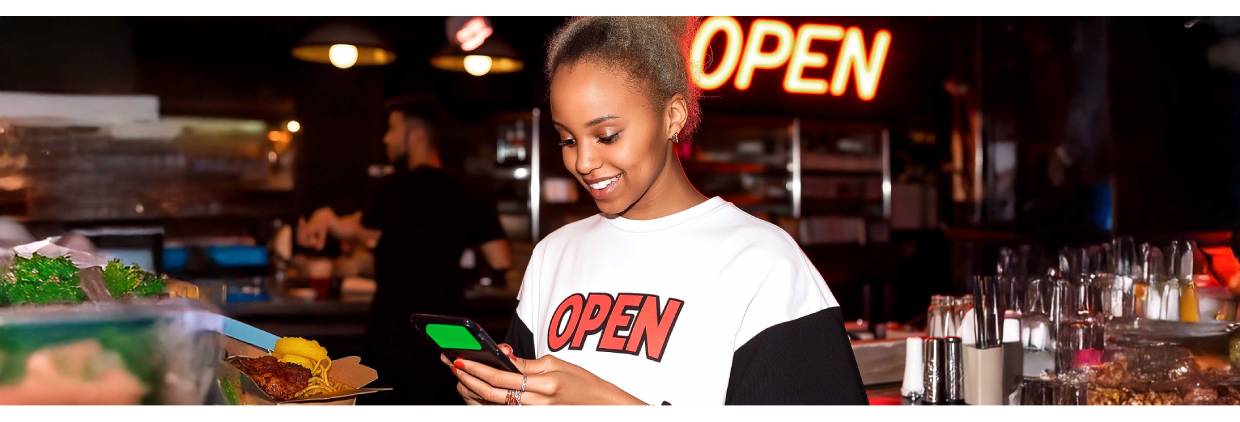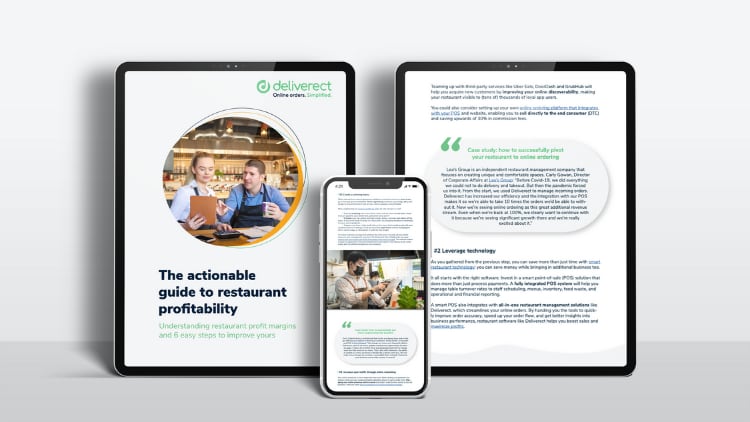Have you ever wondered why some restaurant brands win in food delivery marketplaces while others struggle for visibility? It’s not just about marketing or food quality - uptime is critical in how often restaurants appear in search results.
The online restaurant marketplace has changed. As more customers continue to rely on online food delivery services for their dining choices, players like Uber Eats, DoorDash, and Deliveroo have become the digital front door for consumers.
Delivery apps function as ordering systems and search engines, ranking restaurants based on key factors. The higher a restaurant brand ranks, the more likely customers are to place an order.
But what happens when locations go offline, even temporarily? The answer is simple - lost revenue from missed sales and marketplace rankings drop. Delivery platforms prioritise reliability—if multiple chain locations are frequently offline due to system errors or manual mistakes, restaurants risk being pushed further down in search results.
In an industry where visibility is everything, being offline means being overlooked. What’s worse, many enterprise restaurant operators don’t realise the actual cost of downtime until they see a decline in sales and revenue - and by then, getting back is an uphill battle.
In this blog, we’ll explore the hidden costs of downtime and how it impacts restaurants’ delivery app marketplace visibility at scale.
What Happens When Your Restaurant Goes Offline?
A very short downtime can have long-lasting effects on restaurants’ immediate sales, customer trust, and overall marketplace visibility. Here is more on what happens when a restaurant goes offline:
Immediate Revenue Loss
The most obvious impact is lost sales. When restaurants go offline on delivery platforms due to technical issues, manual errors, or kitchen disruptions, customers who are there and ready to place an order don’t stick around - they move to another available option and take their business with them.
Now multiply this effect across multiple chain locations for a month. Even a short outage during peak lunch or dinner trade could lead to dozens (if not hundreds) of missed orders and thousands in lost revenue. At scale, the impact on the chain restaurants’ revenue multiplies quickly, making reliability crucial in maintaining marketplace performance.
Loss of Customer Trust and Order Volume
If a customer tries to order from a restaurant twice and it’s unavailable, they will probably not try a third time. Availability matters, and when restaurants are offline more often than online, customers start to think that the place is either closed or not dependable.
This doesn’t just affect sales in the immediate term — it involves a restaurant’s long-term order volume. Essentially, fewer people consider these restaurants as an option in the first place. Even loyal customers will start looking elsewhere if they can’t count on a restaurant to be available when they’re ready to order.
Algorithm Penalties
Here’s where things get even trickier. Delivery platforms like Uber Eats, DoorDash, and Deliveroo don’t just list restaurants – they actively rank them. Their algorithms prioritise restaurants that meet the following criteria:
● Consistently available.
● Have high fulfilment rates.
● Maintain customer satisfaction.
When restaurants go offline, their reliability at scale can take a hit. Rankings can get penalised and suppressed, meaning customers are less likely to see them, even when they’re back online. Suppressed visibility means fewer orders and ultimately lost revenue.
The True Cost of Downtime
From lost customers to increased marketing spend, downtime creates hidden expenses that many enterprise restaurant operators don’t realise until it’s too late.
Lost Revenue per Hour and Per Day
Suppose a restaurant typically makes $500 per hour in delivery sales and suddenly has two hours of downtime. In that case, it has just lost $1,000 - plus the opportunity cost of all those potentially disgruntled, never-to-return customers.
Now consider that happening to multiple chain locations many times in one month.
For chain restaurants that get most of their business from delivery, short outages during peak hours (lunch and dinner rush) can be detrimental to their revenues. 5 hours a week = $10,000+ in lost revenue each month = $120,000+ per year of potential lost revenue—if not more.
And it’s not just the missed orders while they are down that hurts. If customers can’t order from them when they want, they may not return, leading to further revenue loss in the weeks ahead. After all, there’s proof time and again that customers will always choose to walk away from a brand if they experience bad service, let alone no service at all.
How Downtime Affects Restaurants Marketplace Rankings
Going offline doesn’t mean missing a few orders — it has a lasting effect on restaurants’ visibility. But have you ever actually thought about how delivery platforms rank restaurants? What causes some restaurants to rank high on online food delivery platforms while others get pushed back 10 pages?
How Delivery Apps Rank Restaurants
Marketplaces like Uber Eats, DoorDash, and Deliveroo are essentially search engines. They aim to match hungry customers with reliable restaurants. And so they prioritise restaurants that check the right boxes, such as:
● High engagement: Restaurants that receive many orders and interact with customers well (e.g., many repeat orders, high ratings) get boosted.
● Successful order fulfilment: Cancelled or missed orders hurt restaurant rankings. A successful, completed order is important to boosting marketplace rankings.
● Reliability and uptime: If restaurants are frequently marked “unavailable,” the algorithm deprioritises them in search results, which could affect the entire chain.
It’s easy to see why. If a restaurant is always down, the algorithm reasons that it may not be a reliable option for ‘hungry’ customers. And in local discovery, that makes it an easy choice to be overlooked in favour of those frequently available.
The Long-Term Impact of Frequent Closures
Here’s what happens to restaurants when downtime becomes a pattern:
● Drop in search visibility: Algorithms factor in availability, and every closure pushes restaurants down the pecking order. Customers can’t quickly locate them even when they get back.
● Lower click-through and order volume: When restaurants are ranked lower, fewer customers see them, leading to fewer orders.
● Algorithm Bias against Your Brand: Over time, platforms deprioritise restaurants with inconsistent availability, favouring those that appear more reliable.
In the end, it’s a vicious cycle that never ends. The lower restaurants rank, the fewer orders they receive. The fewer orders they receive, the harder it becomes to regain a strong ranking position.
How to Prevent Downtime and Protect Restaurant Rankings
The good news is that enterprise restaurant operators can take control and prevent these issues before they impact other locations. Here is how:
Use Automation and Smart Monitoring Tools like Pulse Sentinel
All restaurants, even the best-run ones, have technology problems. But catching them early is what matters. A momentary system failure shouldn’t mean hours of lost revenue. That’s what an automation and monitoring tool like Pulse Sentinel does for chain restaurants.
Pulse Sentinel can help chain restaurants outsmart competition and grow organically on delivery apps’ marketplaces —ensuring their online presence is not interrupted. The tool helps restaurant operators to:
● Gain insights that matter: Track delivery app and location-based competitor performance, view store performance history, and monitor downtime.
● Real-time visibility: With Pulse Sentinel, enterprise restaurant operators can receive email alerts if one store in the location chain is detected offline on any delivery app during active business hours.
● Open stores automatically: Pulse Sentinel allows restaurant operators to determine conditions under which they would prefer the platform to re-open stores automatically after going offline.
Many operators don’t realise when restaurants go offline until order volume drops and revenue declines. By taking advantage of automation and smart monitoring tools like Pulse Sentinel, they can remain proactive in uptime monitoring and stay ahead of the curve.
Implement Best Practices for Operational Efficiency
But beyond technology, keeping things running smoothly helps ensure restaurant systems are up. There are a few simple best practices that can help restaurant operators avoid most of the common causes of downtime. These are:
● Staff training: Train staff on efficiently processing orders, updating stock, and handling common downtime issues.
● Improve order fulfilment speed: Delivery platforms provide preferential treatment to restaurants that quickly fulfil orders. Ensure restaurant kitchens have a well-orchestrated flow to avoid any lag time.
Conclusion
Downtime poses a direct threat to the success of restaurants. Every minute that restaurants are offline results in lost sales, lower search rankings, and reduced customer confidence.
Lost visibility equals lost customers. When restaurants are often “unavailable,” customers stop looking and choose competitors. The costs extend beyond missed orders to increased spending to regain competitiveness, compounded by negative customer sentiment downtime.
Solutions like Pulse Sentinel help multi-location restaurant operators protect uptime, identify real-time issues, and remediate them automatically, often before affecting marketplace rankings. Discover today how Pulse Sentinel can do that for your restaurant.






